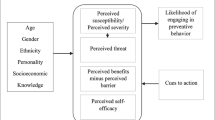Abstract
To examine factors associated with perceived susceptibility to cervical cancer among Latina immigrants in two counties in Alabama. Datasets from two anonymous cross-sectional surveys from two studies were combined for these analyses. The total sample size was 743 women. Participants’ average age was 30 ± 6.8 years and they were mainly from Mexico (89.2%). Almost 36% of the participants did not perceive themselves as being susceptible to cervical cancer, 33.9% did not know if they were susceptible, and 30.4% perceived themselves as susceptible. Educational attainment, thinking they may have been exposed to an STI in the past, thinking they may be at risk of HPV currently, having had a Pap smear within the last year, and having a relative with cancer were significantly associated with perceived susceptibility to cervical cancer in the multinomial logistic regression. Greater knowledge about cervical cancer risk factors reduced the uncertainty about perceived susceptibility. Perceived susceptibility to cervical cancer seems to be influenced more importantly by the current or past perception of HPV/STI exposure, and by having a relative with cancer. This finding is critical in the development of interventions that are tailored to Latina immigrants as well as efforts to educate providers in a state where Latino immigration is a recent phenomenon.
Similar content being viewed by others
References
Ramirez, R. R., & de la Cruz, G. P. (2002). The Hispanic population in the United States: March 2002. Current Population Reports, P20–545.
Kochhar, R., Suro, R., & Tafoya, S. (2005). The New Latino South: The context and consequences of rapid population growth. Washington, DC: Pew Hispanic Center.
US Census Bureau (2008). American Community Survey.
DeNavas-Walt C., Proctor B. D., Jessica S. (2007). Income, poverty, and health insurance coverage in the United Stats: 2006. In Bureau USC (Ed.), Current Population Reports (pp. 60–233). Washington, DC: U.S. Government Printing Office.
US Census Bureau. Current Population Survey (2006) Annual social and economic supplement, ethnicity and ancestry statistics branch, population division.
US Cancer Statistics Working Group. (2009). United States cancer statistics: 1999–2005 incidence and mortality web-based report. Atlanta: US Department of Health and Human Services, Centers for Disease Control and Prevention and National Cancer Institute.
Ferlay, J., Shin, H., Bray, F., Forman, D., Mathers, C., & Parkin, D. (2010). GLOBOCAN 2008, Cancer incidence and mortality worldwide: IARC cancerbase No. 10 [Internet]. Lyon: IARCPress.
Carrasquillo, O., & Pati, S. (2004). The role of health insurance on Pap smear and mammography utilization by immigrants living in the United States. Preventive Medicine, 39(5), 943–950.
Byrd, T. L., Chavez, R., & Wilson, K. M. (2007). Barriers and facilitators of cervical cancer screening among Hispanic women. Ethnicity and Disease, 17(1), 129–134.
Selvin, E., & Brett, K. M. (2003). Breast and cervical cancer screening: sociodemographic predictors among white, black, and hispanic women. American Journal of Public Health, 93(4), 618–623.
Rodriguez, M. A., Ward, L. M., & Perez-Stable, E. J. (2005). Breast and cervical cancer screening: impact of health insurance status, ethnicity, and nativity of Latinas. Annals of family medicine, 3(3), 235–241.
Scarinci, I. C., Beech, B. M., Kovach, K. W., & Bailey, T. L. (2003). An examination of sociocultural factors associated with cervical cancer screening among low-income Latina immigrants of reproductive age. Journal of Immigrant Health, 5(3), 119–128.
McCaul, K., Branstetter, A., Schroeder, D., & Glasgow, R. (1996). What is the relationship between breast cancer risk and mammography screening? A meta-analytic review. Health Psychology, 15(6), 423–429.
Odedina, F., Campbell, E., LaRose-Pierre, M., Scrivens, J., & Hill, A. (2008). Personal factors affecting African-American men’s prostate cancer screening behavior. Journal of the National Medical Association, 100(6), 724–733.
Frank, D., Swedmark, J., & Grubbs, L. (2004). Colon cancer screening in African American women. ABNF Journal, 15(4), 67–70.
Glanz, K., Rimer, B. K., & Lewis, F. M. (2002). Health behavior and health education: Theory, research, and practice (3rd ed.). San Francisco: Jossey-Bass.
Katapodi, M. C., Lee, K. A., Facione, N. C., & Dodd, M. J. (2004). Predictors of perceived breast cancer risk and the relation between perceived risk and breast cancer screening: A meta-analytic review. Preventive Medicine, 38(4), 388–402.
McQueen, A., Swank, P., Bastian, L., & Vernon, S. (2008). Predictors of perceived susceptibility of breast cancer and changes over time: A mixed modeling approach. Health Psychology, 27(1), 68–77.
Redding, K., Funkhouser, E., Garcés-Palacio, I., Person, S., Kempf, M., & Scarinci, I. (2010). Vaginal douching among latina immigrants. Matern Child Health Journal, 14(2):274–282.
SPSS 11.5 ed. Chicago, IL: SPSS Inc.
Marlow, L., Waller, J., & Wardle, J. (2009). The impact of human papillomavirus information on perceived risk of cervical cancer. Cancer Epidemiology, Biomarkers and Prevention, 18(2), 373–376.
Kim, S., Pérez-Stable, E., Wong, S., et al. (2008). Association between cancer risk perception and screening behavior among diverse women. Archives of Internal Medicine, 168(7), 728–734.
Honda, K., & Neugut, A. (2004). Associations between perceived cancer risk and established risk factors in a national community sample. Cancer Detection and Prevention, 28(1), 1–7.
Vernon, S. (1999). Risk perception and risk communication for cancer screening behaviors: A review. Journal of the National Cancer Institute. Monographs, 25, 101–119.
Acknowledgments
This study was supported by grants from the National Cancer Institute (R03-CA093143 and R01-CA111799).
Author information
Authors and Affiliations
Corresponding author
Rights and permissions
About this article
Cite this article
Garcés-Palacio, I.C., Scarinci, I.C. Factors Associated with Perceived Susceptibility to Cervical Cancer Among Latina Immigrants in Alabama. Matern Child Health J 16, 242–248 (2012). https://doi.org/10.1007/s10995-010-0737-x
Published:
Issue Date:
DOI: https://doi.org/10.1007/s10995-010-0737-x




